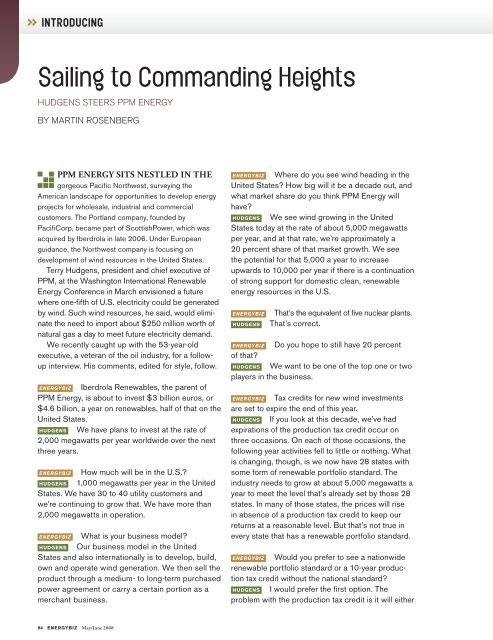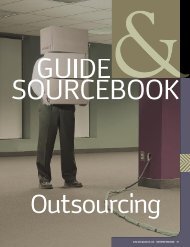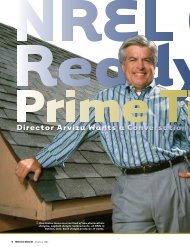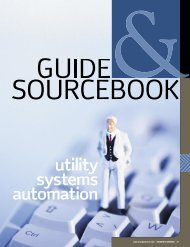sailing to commanding heights
sailing to commanding heights
sailing to commanding heights
Create successful ePaper yourself
Turn your PDF publications into a flip-book with our unique Google optimized e-Paper software.
» INTROdUCING<br />
<strong>sailing</strong> <strong>to</strong> <strong>commanding</strong> <strong>heights</strong><br />
huDgens steeRs PPM eneRgy<br />
By MaRtin RosenBeRg<br />
ppm energy SitS neStleD in the<br />
gorgeous Pacific Northwest, surveying the<br />
American landscape for opportunities <strong>to</strong> develop energy<br />
projects for wholesale, industrial and commercial<br />
cus<strong>to</strong>mers. The Portland company, founded by<br />
PacifiCorp, became part of ScottishPower, which was<br />
acquired by Iberdrola in late 2006. Under European<br />
guidance, the Northwest company is focusing on<br />
development of wind resources in the United States.<br />
Terry Hudgens, president and chief executive of<br />
PPM, at the Washing<strong>to</strong>n International Renewable<br />
Energy Conference in March envisioned a future<br />
where one-fifth of U.S. electricity could be generated<br />
by wind. Such wind resources, he said, would eliminate<br />
the need <strong>to</strong> import about $250 million worth of<br />
natural gas a day <strong>to</strong> meet future electricity demand.<br />
We recently caught up with the 53-year-old<br />
executive, a veteran of the oil industry, for a followup<br />
interview. His comments, edited for style, follow.<br />
EnErgyBiz Iberdrola Renewables, the parent of<br />
PPM Energy, is about <strong>to</strong> invest $3 billion euros, or<br />
$4.6 billion, a year on renewables, half of that on the<br />
United States.<br />
huDgEns We have plans <strong>to</strong> invest at the rate of<br />
2,000 megawatts per year worldwide over the next<br />
three years.<br />
EnErgyBiz How much will be in the U.S.?<br />
huDgEns 1,000 megawatts per year in the United<br />
States. We have 30 <strong>to</strong> 40 utility cus<strong>to</strong>mers and<br />
we’re continuing <strong>to</strong> grow that. We have more than<br />
2,000 megawatts in operation.<br />
EnErgyBiz What is your business model?<br />
huDgEns Our business model in the United<br />
States and also internationally is <strong>to</strong> develop, build,<br />
own and operate wind generation. We then sell the<br />
product through a medium- <strong>to</strong> long-term purchased<br />
power agreement or carry a certain portion as a<br />
merchant business.<br />
94 EnErgyBiz May/June 2008<br />
EnErgyBiz Where do you see wind heading in the<br />
United States? How big will it be a decade out, and<br />
what market share do you think PPM Energy will<br />
have?<br />
huDgEns We see wind growing in the United<br />
States <strong>to</strong>day at the rate of about 5,000 megawatts<br />
per year, and at that rate, we’re approximately a<br />
20 percent share of that market growth. We see<br />
the potential for that 5,000 a year <strong>to</strong> increase<br />
upwards <strong>to</strong> 10,000 per year if there is a continuation<br />
of strong support for domestic clean, renewable<br />
energy resources in the U.S.<br />
EnErgyBiz That’s the equivalent of five nuclear plants.<br />
huDgEns That’s correct.<br />
EnErgyBiz Do you hope <strong>to</strong> still have 20 percent<br />
of that?<br />
huDgEns We want <strong>to</strong> be one of the <strong>to</strong>p one or two<br />
players in the business.<br />
EnErgyBiz Tax credits for new wind investments<br />
are set <strong>to</strong> expire the end of this year.<br />
huDgEns If you look at this decade, we’ve had<br />
expirations of the production tax credit occur on<br />
three occasions. On each of those occasions, the<br />
following year activities fell <strong>to</strong> little or nothing. What<br />
is changing, though, is we now have 28 states with<br />
some form of renewable portfolio standard. The<br />
industry needs <strong>to</strong> grow at about 5,000 megawatts a<br />
year <strong>to</strong> meet the level that’s already set by those 28<br />
states. In many of those states, the prices will rise<br />
in absence of a production tax credit <strong>to</strong> keep our<br />
returns at a reasonable level. But that’s not true in<br />
every state that has a renewable portfolio standard.<br />
EnErgyBiz Would you prefer <strong>to</strong> see a nationwide<br />
renewable portfolio standard or a 10-year production<br />
tax credit without the national standard?<br />
huDgEns I would prefer the first option. The<br />
problem with the production tax credit is it will either
wE hAvE PlAns <strong>to</strong> InvEst At<br />
thE rAtE oF 2,000 mEgAwAtts<br />
PEr yEAr worldwIdE ovEr<br />
thE nExt thrEE yEArs.<br />
Terry Hudgens<br />
Pho<strong>to</strong> CourtEsy of PPm EnErgy<br />
be <strong>to</strong>o rich or not rich enough, depending upon circumstances<br />
down the road. It requires companies<br />
<strong>to</strong> have substantial taxable incomes <strong>to</strong> fully utilize<br />
the tax credit.<br />
EnErgyBiz So a national renewable portfolio<br />
standard really would set the standards for a longer<br />
period and allow your business <strong>to</strong> evolve?<br />
huDgEns It would. It puts the burden on industry<br />
<strong>to</strong> work <strong>to</strong>gether <strong>to</strong> develop what is the most<br />
cost-efficient way of meeting the standard, and that<br />
working <strong>to</strong>gether is required <strong>to</strong> see expansions in<br />
infrastructure, particularly in grid, <strong>to</strong> allow for wind<br />
and other renewables <strong>to</strong> realize their full potential.<br />
EnErgyBiz Europe has embraced wind.<br />
huDgEns Northern Germany is on track for using<br />
wind <strong>to</strong> generate 20 percent of its electricity. Spain<br />
is at 8 percent with goals <strong>to</strong> get <strong>to</strong>ward 20 percent.<br />
A lot of Europe is well on the way <strong>to</strong> getting<br />
20 percent of their energy from wind.<br />
EnErgyBiz The United States is still around<br />
1 percent, right?<br />
huDgEns … a little bit more than 1 percent, but big<br />
growth. The United States has much superior wind<br />
resources than Europe.<br />
EnErgyBiz Will the United States ever get 20 percent<br />
of its electricity from wind?<br />
huDgEns Well, that would be over 300,000 megawatts<br />
of wind capacity. We’re <strong>to</strong>day at about 15,000.<br />
www.energycentral.com EnErgyBiz 95
» INTROdUCING<br />
EnErgyBiz We need substantial grid investment <strong>to</strong><br />
support renewables like wind. Will that investment<br />
be made?<br />
huDgEns Yes. I think it is going <strong>to</strong> happen.<br />
EnErgyBiz What about the intermittency of wind?<br />
Can we have one-fifth of our generation tied <strong>to</strong> wind?<br />
huDgEns Absolutely. Again, I’ll just point <strong>to</strong> Europe.<br />
They’re doing it there. In fact, if you look at Denmark,<br />
they don’t have nearly the diversity and flexibility of<br />
resources we have in many parts of the U.S.<br />
EnErgyBiz The main difference, though, is the vast<br />
geographic expanse of the United States.<br />
huDgEns We ship power large distances already<br />
in the United States. Look at where hydro facilities<br />
are, where coal facilities are. They are not close <strong>to</strong><br />
the load centers.<br />
EnErgyBiz What will our future generation mix<br />
look like?<br />
huDgEns We’re going <strong>to</strong> back off coal over the next<br />
10 <strong>to</strong> 15 years until the coal industry decides <strong>to</strong> get real<br />
on developing clean coal. I’m talking about sequestration.<br />
Anything else is just nonsense in my mind.<br />
EnErgyBiz Where do you see coal going? Down<br />
<strong>to</strong> 30 percent of our generation?<br />
huDgEns Yes, I think probably down <strong>to</strong> the<br />
30 percent range.<br />
EnErgyBiz Do you see nuclear growth?<br />
huDgEns Not for a while, but in the long run, I<br />
believe it probably will grow.<br />
EnErgyBiz Where do you see most of the new<br />
wind generation going?<br />
huDgEns It’s going <strong>to</strong> be a bit of everywhere,<br />
frankly. It’s probably going <strong>to</strong> make sense <strong>to</strong> build<br />
some large resource in the Midwest and transportation<br />
from the Midwest.<br />
EnErgyBiz Do you see a future for offshore wind<br />
here similar <strong>to</strong> what’s now being developed in<br />
Europe?<br />
huDgEns I do. But <strong>to</strong>day, the cost for offshore wind<br />
is not very competitive with the onshore wind, and<br />
we have plenty of good onshore wind <strong>to</strong> continue <strong>to</strong><br />
work on.<br />
EnErgyBiz What attitude are you finding among utilities<br />
executives in the United States? Are they increasingly<br />
interested in wind, or are some still skeptical?<br />
96 EnErgyBiz May/June 2008<br />
huDgEns We went through a period the last three<br />
years where we’ve had amazing, increasing receptivity<br />
and interest in wind among many of the utilities<br />
with probably the exception of the Southeast,<br />
because they just don’t really have any wind. They<br />
continue <strong>to</strong> be skeptical as <strong>to</strong> how much concentration<br />
of wind they can have, but it’s helpful <strong>to</strong> have<br />
good examples like Denmark, Germany and Spain,<br />
<strong>to</strong> point <strong>to</strong>.<br />
EnErgyBiz Describe the corporate culture at PPM.<br />
huDgEns We started, well, really in 2001. The<br />
culture and the basis for building the company was<br />
<strong>to</strong> establish a strong merchant competitive business<br />
in the United States with its own independent<br />
culture. We’re an energy provider of gas, electricity,<br />
a variety of structured products, and, of course, a<br />
lot of wind development and gas s<strong>to</strong>rage development.<br />
PPM grew from nine people <strong>to</strong> 600 during the<br />
period of 2001 <strong>to</strong> 2007.<br />
EnErgyBiz You worked for Texaco for 25 years.<br />
How is your current job different from working for a<br />
major oil company?<br />
huDgEns I love the oil and gas business and what<br />
we were doing. But this is a business that has a<br />
lot more excitement, a lot more future. The biggest<br />
difference is when I go <strong>to</strong> speak publicly or visit<br />
with politicians or local government we’re a lot more<br />
welcome. People see us as doing work that’s really<br />
benefitting society.
Consider us the<br />
grown-ups of the industry<br />
Vestas has installed wind turbines in 63 countries on fi ve continents.<br />
Our wind and site experience is unmatched.<br />
vestas.com















![View From the Trenches [PDF]](https://img.yumpu.com/18854438/1/190x252/view-from-the-trenches-pdf.jpg?quality=85)
